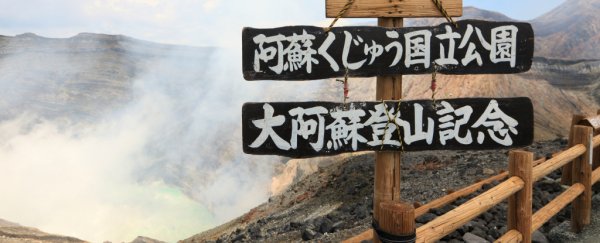Researchers in Japan have discovered that Mount Aso – the country's most active volcano – might have quelled the ruptures of a 7.1-magnitude earthquake that hit the region on 16 April 2016.
Not only did the volcano's underground magma chamber save parts of the area from the vicious quake, the discovery offers an ultra-rare look at how two powerful geological phenomena interact, which could help researchers to better predict and prepare for potentially deadly quakes around the world.
"This is the first case concerning the interaction between the volcano and co-seismic rupturing as we know so far," study leader Aiming Lin from Kyoto University told Mindy Weisberger at Live Science.
The team says that the 7.1-magnitude quake originated in Kumamoto and spread ruptures outward that extended about 40 kilometres (25 miles) in different directions. After the quake subsided, the team spent 10 days investigating all of these ruptures.
While most were pretty standard, they noticed that the rupture that headed towards Mount Aso suddenly halted in the volcano's caldera – the large bowl-like dent at the volcano's summit – which lay roughly 30 kilometres (19 miles) from the quake's epicentre.
After further seismic analysis, the team says a pool of magma 6 kilometres (3.7 miles) beneath the volcano likely dissipated the quake's energy by sending it upward and out, instead of allowing it to continue moving forward.
"The co-seismic surface ruptures cut Aso caldera and two volcanic cones inside the caldera, but terminate in the caldera," the team wrote. "The findings show that north-eastward propagation of co-seismic rupturing terminated in Aso caldera because of the presence of magma beneath the Aso volcanic cluster."
In other words, the volcano's magma chamber provided enough heat and liquid to create a very large earthquake 'blocker' that inhibited the quake's energy from continuing on its path.
While this is the first time that researchers have been able to study how volcanoes and earthquakes interact with one another, Lin says there is historical evidence that volcanoes have stopped other quakes in the past, reports Weisberger.
Specifically, the 8.7-magnitude Houei-Tokai-Nankai earthquake that struck Japan in 1707 that might have been halted by Mount Fuji. Then, in 1903, the 7.3-magnitude North Izu earthquake was potentially dissipated by the Hakone volcano.
The team hopes that their research will provide a way to assess the potential dangers of earthquakes in the future, though it's important to remember that it's extremely difficult to predict when and where an earthquake might hit. The real goal is to access the potential dangers of certain areas and create a plan of action for when one does strike.
This isn't the only time Mount Aso has been in the news lately. Earlier this month, the large volcano erupted, sending ash a remarkable 11 kilometres (6.8 miles) into the sky, reports Erik Klemetti at Wired.
The crazy thing is that Lin and her colleagues might have actually predicted the eruption with their study, which was submitted for publication long before the recent eruption occurred.
They explain in the study's press release:
"Magma is fluid so it absorbs stress. That's why the damage – the co-seismic rupturing – shouldn't travel any further. Large earthquakes often accompany or precede volcanic eruptions.
The presence of magma does have an association with the distribution of active faults. But whether volcanoes affect the fault rupturing following an earthquake remained unclear due to the lack of case studies."
So now we have at least one case study on record. Hopefully, with all of the data collected from the quake and the eruption that followed, researchers will finally shed light on some of these crazy – and potentially disastrous – geological phenomena.
The team's work was published in Science.
